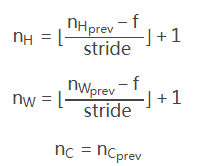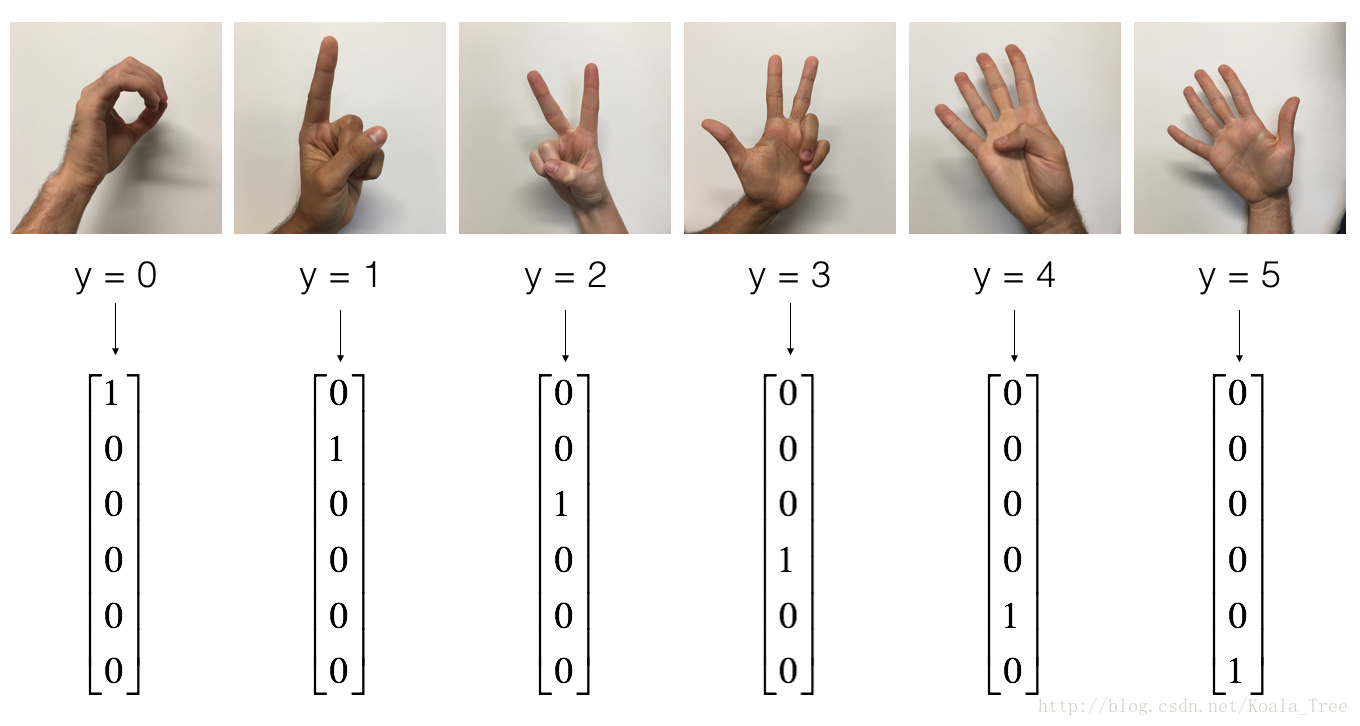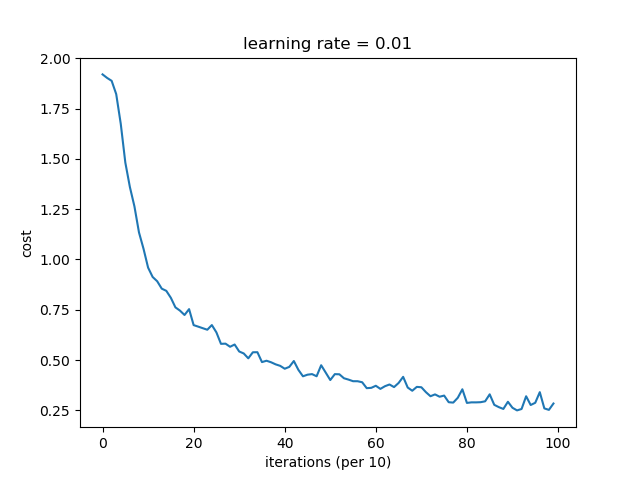吳恩達Coursera深度學習(4-1)程式設計練習
阿新 • • 發佈:2019-01-10
Class 4:卷積神經網路
Week 1:卷積神經網路基礎
目錄
1、CNN: Step by Step
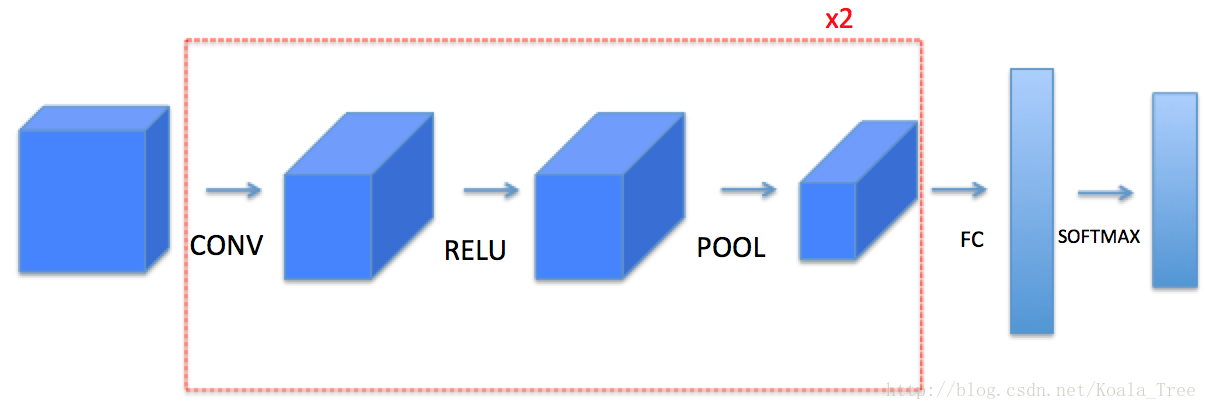
(1)卷積層
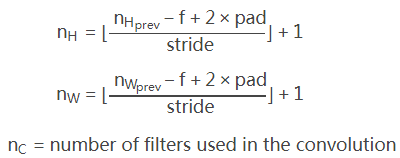
(2)池化層
import numpy as np
import matplotlib.pyplot as plt
import h5py
# matplotlib inline
plt.rcParams['figure.figsize'] = (5.0, 4.0) # set default size of plots
plt.rcParams['image.interpolation'] = 'nearest'
plt.rcParams['image.cmap' x.shape = (4, 3, 3, 2)
x_pad.shape = (4, 7, 7, 2)
x[1,1] = [[ 0.90085595 -0.68372786]
[-0.12289023 -0.93576943]
[-0.26788808 0.53035547]]
x_pad[1,1] = [[ 0. 0.]
[ 0. 0.]
[ 0. 0.]
[ 0. 0.]
[ 0. 0.]
[ 0. 0.]
[ 0. 0.]]
Z = [[[-6.1034344]]]
Z's mean = 0.0489952035289
Z[3,2,1] = [-0.61490741 -6.7439236 -2.55153897 1.75698377 3.56208902 0.53036437
5.18531798 8.75898442]
cache_conv[0][1][2][3] = [-0.20075807 0.18656139 0.41005165]
mode = max
A = [[[[ 1.74481176 0.86540763 1.13376944]]]
[[[ 1.13162939 1.51981682 2.18557541]]]]
mode = average
A = [[[[ 0.02105773 -0.20328806 -0.40389855]]]
[[[-0.22154621 0.51716526 0.48155844]]]]
dA_mean = 1.45243777754
dW_mean = 1.72699145831
db_mean = 7.83923256462
x = [[ 1.62434536 -0.61175641 -0.52817175]
[-1.07296862 0.86540763 -2.3015387 ]]
mask = [[ True False False]
[False False False]]
distributed value = [[ 0.5 0.5]
[ 0.5 0.5]]
mode = max
mean of dA = 0.145713902729
dA_prev[1,1] = [[ 0. 0. ]
[ 5.05844394 -1.68282702]
[ 0. 0. ]]
mode = average
mean of dA = 0.145713902729
dA_prev[1,1] = [[ 0.08485462 0.2787552 ]
[ 1.26461098 -0.25749373]
[ 1.17975636 -0.53624893]]2、CNN:TensorFlow
import math
import h5py
import scipy
import numpy as np
import tensorflow as tf
import matplotlib.pyplot as plt
from tensorflow.python.framework import ops
from PIL import Image
from cnn_utils import *
np.random.seed(1)
# 1、搭建 CNN
# 1-1、建立佔位符
def create_placeholders(n_H0, n_W0, n_C0, n_y):
"""
Creates the placeholders for the tensorflow session.
Arguments:
n_H0 -- scalar, height of an input image
n_W0 -- scalar, width of an input image
n_C0 -- scalar, number of channels of the input
n_y -- scalar, number of classes
Returns:
X -- placeholder for the data input, of shape [None, n_H0, n_W0, n_C0] and dtype "float"
Y -- placeholder for the input labels, of shape [None, n_y] and dtype "float"
"""
X = tf.placeholder(tf.float32, shape=[None, n_H0, n_W0, n_C0])
Y = tf.placeholder(tf.float32, shape=[None, n_y])
return X,Y
X, Y = create_placeholders(64, 64, 3, 6)
print ("X = " + str(X))
print ("Y = " + str(Y))
# 1-2、初始化引數
def initialize_parameters():
"""
Initializes weight parameters to build a neural network with tensorflow.
The shapes are:
W1 : [4, 4, 3, 8]
W2 : [2, 2, 8, 16]
Returns:
parameters -- a dictionary of tensors containing W1, W2
"""
tf.set_random_seed(1)
W1 = tf.get_variable("W1", [4,4,3,8], initializer=tf.contrib.layers.xavier_initializer(seed=0))
W2 = tf.get_variable("W2", [2,2,8,16], initializer=tf.contrib.layers.xavier_initializer(seed=0))
parameters = {"W1":W1,
"W2":W2}
return parameters
tf.reset_default_graph()
with tf.Session() as sess_test:
parameters = initialize_parameters()
init = tf.global_variables_initializer()
sess_test.run(init)
print("W1 = " + str(parameters["W1"].eval()[1,1,1])) # eval()將字串轉換成列表、字典、元組
print("W2 = " + str(parameters["W2"].eval()[1,1,1]))
# 1-3、前向傳播
def forward_propagation(X, parameters):
"""
Implements the forward propagation for the model:
CONV2D -> RELU -> MAXPOOL -> CONV2D -> RELU -> MAXPOOL -> FLATTEN -> FULLYCONNECTED
Arguments:
X -- input dataset placeholder, of shape (input size, number of examples)
parameters -- python dictionary containing your parameters "W1", "W2"
the shapes are given in initialize_parameters
Returns:
Z3 -- the output of the last LINEAR unit
"""
W1 = parameters['W1']
W2 = parameters['W2']
# 第一層卷積、啟用、最大池化 2*64*64*3 -> 2*64*64*8 -> 2*8*8*8
Z1 = tf.nn.conv2d(X, W1, strides=[1,1,1,1], padding='SAME') #"SAME"輸入輸出特徵維度相同
A1 = tf.nn.relu(Z1)
P1 = tf.nn.max_pool(A1, ksize=[1,8,8,1], strides=[1,8,8,1], padding='SAME')
# 第二層卷積、啟用、最大池化 2*8*8*8 -> 2*8*8*16 -> 2*2*2*16
Z2 = tf.nn.conv2d(P1, W2, strides=[1,1,1,1], padding='SAME') #"VALID"沒有填充
A2 = tf.nn.relu(Z2)
P2 = tf.nn.max_pool(A2, ksize=[1,4,4,1], strides=[1,4,4,1], padding='SAME')
# 全連線之前,平鋪 2*2*2*16 -> 2*64
P2 = tf.contrib.layers.flatten(P2)
# 全連線層 2*64 -> 2*6
# 沒有線性啟用函式,不呼叫softmax,輸出層6個神經元,
Z3 = tf.contrib.layers.fully_connected(P2, 6, activation_fn=None)
return Z3
tf.reset_default_graph()
with tf.Session() as sess:
np.random.seed(1)
X, Y = create_placeholders(64, 64, 3, 6)
parameters = initialize_parameters()
Z3 = forward_propagation(X, parameters)
init = tf.global_variables_initializer()
sess.run(init)
a = sess.run(Z3, {X: np.random.randn(2,64,64,3), Y: np.random.randn(2,6)})
print("Z3 = " + str(a))
# 1-4、計算代價函式
def compute_cost(Z3, Y):
"""
Computes the cost
Arguments:
Z3 -- output of forward propagation (output of the last LINEAR unit),
of shape (6, number of examples)
Y -- "true" labels vector placeholder, same shape as Z3
Returns:
cost - Tensor of the cost function
"""
cost = tf.reduce_mean(tf.nn.softmax_cross_entropy_with_logits(logits=Z3, labels=Y))
return cost
tf.reset_default_graph()
with tf.Session() as sess:
np.random.seed(1)
X, Y = create_placeholders(64, 64, 3, 6)
parameters = initialize_parameters()
Z3 = forward_propagation(X, parameters)
cost = compute_cost(Z3, Y)
init = tf.global_variables_initializer()
sess.run(init)
a = sess.run(cost, {X: np.random.randn(4,64,64,3), Y: np.random.randn(4,6)})
print("cost = " + str(a))
# 1-5、model
def model(X_train, Y_train, X_test, Y_test, learning_rate=0.01,
num_epochs=100, minibatch_size=64, print_cost=True):
"""
Implements a three-layer ConvNet in Tensorflow:
CONV2D -> RELU -> MAXPOOL -> CONV2D -> RELU -> MAXPOOL -> FLATTEN -> FULLYCONNECTED
Arguments:
X_train -- training set, of shape (None, 64, 64, 3)
Y_train -- test set, of shape (None, n_y = 6)
X_test -- training set, of shape (None, 64, 64, 3)
Y_test -- test set, of shape (None, n_y = 6)
learning_rate -- learning rate of the optimization
num_epochs -- number of epochs of the optimization loop
minibatch_size -- size of a minibatch
print_cost -- True to print the cost every 100 epochs
Returns:
train_accuracy -- real number, accuracy on the train set (X_train)
test_accuracy -- real number, testing accuracy on the test set (X_test)
parameters -- parameters learnt by the model. They can then be used to predict.
"""
ops.reset_default_graph() # 能重新執行模型,而不會覆蓋tf變數
tf.set_random_seed(1) # 保持結果的一致性(tensorflow seed)
seed=3 # 保持結果的一致性(numpy seed)
(m, n_H0, n_W0, n_C0) = X_train.shape
n_y = Y_train.shape[1]
costs = []
# 構建 tf 模型
X, Y = create_placeholders(n_H0, n_W0, n_C0, n_y)
parameters = initialize_parameters()
Z3 = forward_propagation(X, parameters)
cost = compute_cost(Z3, Y)
optimizer = tf.train.AdamOptimizer(learning_rate).minimize(cost)
init = tf.global_variables_initializer()
# start the Session to compute the tensorflow graph
with tf.Session() as sess:
# run the initialization
sess.run(init)
for epoch in range(num_epochs):
minibatch_cost = 0.
num_minibatches = int(m/minibatch_size)
seed = seed + 1
minibatches = random_mini_batches(X_train, Y_train, minibatch_size, seed)
for minibatch in minibatches:
(minibatch_X, minibatch_Y) = minibatch
# run the session to execute the optimizer and the cost
# the feed_dict should contain a minibatch for (X, Y)
_, temp_cost = sess.run([optimizer, cost], feed_dict={X:minibatch_X, Y:minibatch_Y})
minibatch_cost += temp_cost/num_minibatches
if print_cost==True and epoch%10==0:
print("cost after epoch %i:%f" % (epoch, minibatch_cost))
if print_cost==True and epoch%1==0:
costs.append(minibatch_cost)
# plot cost
plt.plot(np.squeeze(costs))
plt.xlabel("iterations (per 10)")
plt.ylabel("cost")
plt.title("learning rate = " + str(learning_rate))
plt.show()
# 計算正確預測
predict_op = tf.argmax(Z3, 1)
correct_prediction = tf.equal(predict_op, tf.argmax(Y, 1))
# 計算測試集正確率
accuracy = tf.reduce_mean(tf.cast(correct_prediction, "float"))
print(accuracy)
train_accuracy = accuracy.eval({X:X_train, Y:Y_train})
test_accuracy = accuracy.eval({X:X_test, Y:Y_test})
print("Train Accuracy:", train_accuracy)
print("Test Accuracy:", test_accuracy)
return train_accuracy, test_accuracy, parameters
# 2、資料處理
# 2-1、下載資料
X_train_orig, Y_train_orig, X_test_orig, Y_test_orig, classes = load_dataset()
# 2-2、顯示資料圖片
index = 6
plt.imshow(X_train_orig[index])
plt.show()
print("y = " + str(np.squeeze(Y_train_orig[:, index])))
# 2-3、將資料歸一化,標籤one-hot
X_train = X_train_orig/255.
X_test = X_test_orig/255.
Y_train = convert_to_one_hot(Y_train_orig, 6).T
Y_test = convert_to_one_hot(Y_test_orig, 6).T
print(X_train.shape, Y_train.shape, X_test.shape, Y_test.shape)
# 3、測試模型
train_accuracy, test_accuracy, parameters = model(X_train, Y_train, X_test, Y_test)
執行結果:
X = Tensor("Placeholder:0", shape=(?, 64, 64, 3), dtype=float32)
Y = Tensor("Placeholder_1:0", shape=(?, 6), dtype=float32)
W1 = [ 0.00131723 0.14176141 -0.04434952 0.09197326 0.14984085 -0.03514394
-0.06847463 0.05245192]
W2 = [-0.08566415 0.17750949 0.11974221 0.16773748 -0.0830943 -0.08058
-0.00577033 -0.14643836 0.24162132 -0.05857408 -0.19055021 0.1345228
-0.22779644 -0.1601823 -0.16117483 -0.10286498]
Z3 = [[-0.44670227 -1.57208765 -1.53049231 -2.31013036 -1.29104376 0.46852064]
[-0.17601591 -1.57972014 -1.4737016 -2.61672091 -1.00810647 0.5747785 ]]
cost = 2.91034
(1080, 64, 64, 3) (1080, 6) (120, 64, 64, 3) (120, 6)
cost after epoch 0:1.920053
cost after epoch 10:0.959578
cost after epoch 20:0.673839
cost after epoch 30:0.542799
cost after epoch 40:0.457058
cost after epoch 50:0.400885
cost after epoch 60:0.372362
cost after epoch 70:0.364956
cost after epoch 80:0.287130
cost after epoch 90:0.263035
Tensor("Mean_1:0", shape=(), dtype=float32)
Train Accuracy: 0.85
Test Accuracy: 0.691667
